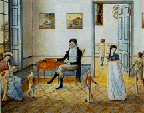
Most floors in early American and European homes consisted of either tamped earth or unvarnished wood and were generally left bare. If enhanced at all, they were covered with rushes, straw, or sand; only in the finest homes were floorcoverings found, and rarely until the 1700s.
The first written reference to a floorcloth is a 1722 British receipt showing that Benjamin Powell paid "for a Bed Tent and...for a floor oyled cloth to lye in the tent." The reference to a "floor" oyled cloth indicates that coated fabrics were already in use as floor coverings.
Early records of the use of floorcloths in America include the personal property inventories taken after the deaths of William Burnet (1688-1729), governor of Massachusetts, and Robert "King" Carter of Virginia (16-1732). George Washington, Thomas Jefferson, and John Adams owned floorcloths. Most of these floorcloths probably came from England; however, near the end of the 18th century, Americans also produced them.
In 1872 the first mail-order catalog, Montgomery Ward, brought a huge assortment of goods - including floorcloths of all sizes - within reach of even the most rural areas.
